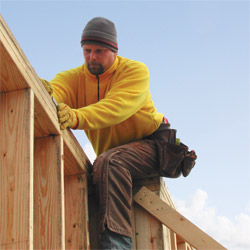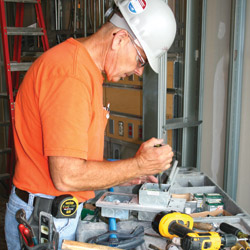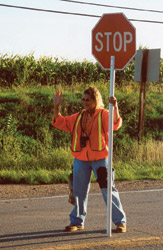The building trades and construction industry require highly-skilled workers in a variety of areas. A trade apprenticeship combines on-the-job experience with academic study and lasts two to five years. Apprenticeship programs are available for the following trades in central Illinois.
Boilermakers
Boilermakers and boilermaker mechanics make, install and repair boilers, vats and other large vessels that hold liquids or gases. Boilers supply steam to drive huge turbines in electric power plants and provide heat and power in buildings, factories and ships. Tanks and vats are used to process and store chemicals, oil, beer and hundreds of other products.
Following blueprints, boilermakers locate and mark reference points on the boiler foundation for installing boilers and other vessels, using straight-edges, squares, transits and tape measures. They attach rigging and signal crane operators to lift heavy frame and plate sections and other parts into place. They align sections, using plumb bobs, levels, wedges and turnbuckles. Boilermakers use hammers, files, grinders and cutting torches to remove irregular edges so the edges fit properly.
Because boilers last a long time, boilermakers regularly maintain them and update components such as burners and boiler tubes to increase efficiency. Boilermaker mechanics maintain and repair boilers and similar vessels. They inspect tubes, fittings, valves, controls and auxiliary machinery, and clean or supervise the cleaning of boilers. They repair or replace defective parts, using hand and power tools, gas torches and welding equipment, and may operate metalworking machinery to repair or make parts. They also dismantle leaky boilers, patch weak spots with metal stock, replace defective sections, or strengthen joints.
Bricklayers and Allied Craftsworkers
Bricklayers and stonemasons work in closely related trades producing attractive, durable surfaces and structures. The work they perform varies in complexity, from laying a simple masonry walkway to installing the ornate exterior of a high-rise building. Bricklayers build walls, floors, partitions, fireplaces, chimneys and other structures with brick, precast masonry panels, concrete block and other masonry materials. Some specialize in installing firebrick linings in industrial furnaces.
Stonemasons build stone walls, as well as set stone exteriors and floors. They work with two types of stone—natural cut, such as marble, granite and limestone, and artificial stone made from concrete, marble chips or other masonry materials. Stonemasons usually work on structures such as houses, hotels and office buildings.
Bricklayers and stonemasons combine a thorough knowledge of brick, concrete block, stone and marble with manual skill to erect very attractive, yet highly durable, structures.
 Carpenters/Millwrights, Cabinetmakers, Floorlayers
Carpenters/Millwrights, Cabinetmakers, Floorlayers
Carpenters are involved in many different kinds of construction activities. They cut, fit and assemble wood and other materials in the construction of buildings, highways, bridges, docks, industrial plants, boats and many other structures. Their duties vary by type of employer. A carpenter employed by a special trade contractor, for example, may specialize in one or two activities, such as setting forms for concrete construction or erecting scaffolding. However, a carpenter employed by a general building contractor may perform many tasks, such as framing walls and partitions, putting in doors and windows, hanging kitchen cabinets and installing paneling and tile ceilings.
Working from blueprints or instructions from supervisors, carpenters first do the layout—measuring, marking and arranging of materials. They then cut and shape wood, plastic, ceiling tile, fiberglass or drywall using hand and power tools, such as chisels, planes, saws, drills and sanders, and then join the materials with nails, screws, staples or adhesives. In the final step, they check the accuracy of their work with levels, rules, plumb bobs and framing scales, and make any necessary adjustments.
Cement Masons
Cement Masons use concrete on many types of construction projects. Whether small jobs such as patios and floors, huge dams, or miles of roadway, cement masons place and finish concrete. They may also color concrete surfaces, expose aggregate (small stones) in walls and sidewalks, or fabricate concrete beams, columns and panels. In preparing a site for placing concrete, masons set the forms for holding the concrete to the desired pitch and depth and properly align them. They then direct the casting of the concrete and supervise laborers who use shovels or special tools to spread it. Masons then guide a straight-edge back and forth across the top of the forms to “screed,” or level, the freshly placed concrete.
 Electricians
Electricians
Electricians install, connect, test and maintain electrical systems for a variety of purposes, including climate control, security and communications. They also install and maintain the electronic controls for machines in business and industry. Electricians work with blueprints when they install electrical systems in factories, office buildings, homes and other structures. Blueprints indicate the location of circuits, outlets, load centers, panel boards and other equipment. Electricians must follow the National Electric Code and comply with state and local building codes when they install these systems.
In addition to wiring a building’s electrical system, electricians may install coaxial or fiber optic cable for computers and other telecommunications equipment. A growing number of electricians install telephone and computer wiring and equipment. They may also connect motors to electrical power and install electronic controls for industrial equipment.
Elevator Constructors
Elevator constructors or elevator mechanics assemble, install and replace elevators, escalators, dumbwaiters, moving walkways and similar equipment in new and old buildings. Once the equipment is in service, they maintain and repair it. They are also responsible for modernizing older equipment. In order to install, repair and maintain modern elevators, which are almost all electronically controlled, elevator constructors must have a thorough knowledge of electronics, electricity and hydraulics. Many elevators today are installed with microprocessors, which are programmed to constantly analyze traffic conditions in order to dispatch elevators in the most efficient manner. With these computer controls, it is now possible to get the greatest amount of service with the least number of cars.
Heat & Frost Insulators
Properly insulated buildings reduce energy consumption by keeping heat in during the winter and out in the summer. Refrigerated storage rooms, vats, tanks, vessels, boilers, and steam and hot water pipes are also insulated to prevent the wasteful transfer of heat. Heat and frost insulators work with commercial and industrial insulation. They install insulation and soundproofing for heating, ventilation, steam generation, process piping and plumbing systems; remove hazardous waste; and clean duct systems.
Iron Workers
Iron workers perform the following steel work: structural, ornamental, reinforcing, and machinery moving and rigging. Iron, steel, aluminum, fiberglass, precast concrete, brass and bronze are important materials in buildings, bridges and other structures. Structural and reinforcing iron workers fabricate, assemble and install these products. They also repair, renovate and maintain older buildings and structures such as steel mills, utility plants, automobile factories, highways and bridges.
Iron workers must erect the steel frames and assemble the cranes and derricks that move structural steel, reinforcing bars, buckets of concrete, lumber, and other materials and equipment around the construction site. This equipment arrives at the construction site in sections. Iron workers then connect the sections and set the cables to do the hoisting.
Structural iron workers begin to connect steel columns, beams and girders according to blueprints and instructions from supervisors and superintendents. Structural steel, reinforcing rods and ornamental iron generally come to the construction site ready for erection.
Reinforcing iron workers set the bars in the forms that hold concrete, following blueprints showing the location, size and number of reinforcing bars. They fasten the bars together by tying wire around them with pliers. When reinforcing floors, workers place blocks under the reinforcing bars to hold them off the deck.
 Laborers
Laborers
Laborers provide much of the physically demanding labor at building, highway and heavy construction projects, tunnel and shaft excavations, and demolition sites. In addition to assisting other trades workers, construction craft laborers clean and prepare sites, dig trenches, set braces to support the sides of excavations, and clean up rubble and debris. They perform a variety of excavation, tunneling and pipe work, and work on their own on highly specialized tasks. The installation of utility pipe, for example, requires the setup and operation of laser guidance equipment for precise pipe elevation and placement. Tunnel and shaft projects require workers to be trained and experienced in the use of drilling equipment and explosives. Construction craft laborers operate jackhammers, earth tampers, cement mixers, buggies, skid steer loaders, “walk behind” ditchdiggers, small mechanical hoists, laser beam equipment, and surveying and measuring equipment.
In addition to working on building and transportation projects, construction craft laborers work on other projects, such as hazardous waste cleanup and asbestos and lead abatement. In hazardous waste removal, they may operate, maintain and read monitoring devices; perform material and atmospheric sampling; build, clean, or maintain facilities for hazardous material removal and decontamination; and package and transport hazardous or radioactive materials.
Operating Engineers
Operating engineers use machinery to move construction materials, earth, petroleum products, coal, grain, manufactured goods and other heavy materials. Generally, they move materials over short distances—around a construction site, factory, warehouse, or on or off trucks and ships. Operators control equipment by moving levers or foot pedals, operating switches, or turning dials. They may also set up and inspect equipment, make adjustments, and perform minor repairs. Operators are classified by the type of equipment they operate: crane and tower operators; excavation and loading machine operators; grader, dozer and scraper operators; hoist and winch operators; or industrial truck and tractor operators.
Painters & Allied Trades
Painters apply paint, stain, varnish and other finishes to buildings and other structures. They choose the right paint or finish for the surface to be covered, taking into account customers’ wishes, durability, ease of handling and method of application. They first prepare the surfaces to be covered so the paint will adhere properly. This may require removing the old coat by stripping, sanding, wire brushing, burning, or water and abrasive blasting. Painters also wash walls and trim to remove dirt and grease, fill nail holes and cracks, sandpaper rough spots and brush off dust. On new surfaces, they apply a primer or sealer to prepare them for the finish coat. Painters also mix paints and match colors, relying on knowledge of paint composition and color harmony.
Paperhangers cover walls and ceilings with decorative wall coverings made of paper, vinyl or fabric. They first prepare the surface to be covered by applying “sizing,” which seals the surface and makes the covering stick better. When redecorating, they may first remove the old covering by soaking, steaming or applying solvents. When necessary, they patch holes and take care of other imperfections before hanging the new wall covering.
Plasterers
Plasterers apply plaster to interior walls and ceilings to form fire-resistant and relatively soundproof surfaces. They also apply plaster to veneer over drywall to create smooth or textured abrasion-resistant finishes. They apply durable plasters such as polymer-based acrylic finishes and stucco to exterior surfaces, and they install prefabricated exterior insulation systems over existing walls for good insulation and interesting architectural effects. In addition, they cast ornamental designs in plaster.
Plumbers, Steamfitters, Sprinklerfitters
Plumbers and steamfitters install, maintain and repair many different types of pipe systems. Some systems move water to a municipal water treatment plant and then to residential, commercial and public buildings. Others dispose of waste. Some bring in gas for stoves and furnaces. Others supply air-conditioning. Pipe systems in power plants carry the steam that powers huge turbines. Pipes are also used in manufacturing plants to move material through the production process.
Although plumbing and steamfitting are sometimes considered a single trade, workers generally specialize in one or the other. Plumbers install and repair the water, waste disposal, drainage and gas systems in homes and in commercial and industrial buildings. They also install plumbing fixtures. Steamfitters install and repair both high- and low-pressure pipe systems used in manufacturing, in the generation of electricity, and in heating and cooling buildings. They also install automatic controls that are increasingly being used to regulate these systems. Sprinklerfitters install automatic fire sprinkler systems in buildings.
Roofers
To protect buildings and their contents, roofers repair and install roofs of tar or asphalt and gravel, rubber, thermoplastic, and metal; and shingles made of asphalt, slate, fiberglass, wood, tile or other material. Repair and reroofing provide many job opportunities for these workers. Roofers may also waterproof foundation walls and floors.
There are two types of roofs—flat and pitched (sloped). Most commercial, industrial and apartment buildings have flat or slightly sloping roofs. Most houses have pitched roofs. Some roofers work on both types, while others specialize.
Sheet Metal Workers
Sheet metal workers make, install and maintain air conditioning, heating, ventilation and pollution-control duct systems, roofs, siding, rain gutters, downspouts, skylights, restaurant equipment, outdoor signs, and many other building parts and products made from metal sheets. They may also work with fiberglass and plastic materials. Although some workers specialize in fabrication, installation or maintenance, most do all three jobs.
Sheet metal workers usually fabricate their products at a shop away from the construction site. They first study plans and specifications to determine the kind and quantity of materials they will need. They then measure, cut, bend, shape and fasten pieces of sheet metal to make duct work, counter tops and other custom products. In an increasing number of shops, sheet metal workers use computerized metalworking equipment. This enables them to experiment with different layouts and to select the one that results in the least waste of material. They cut or form the parts with computer-controlled saws, lasers, shears and presses. iBi
Source: Union Building Trades Apprenticeship Programs: Your Blueprint to Success, provided by PALM/TRICON


